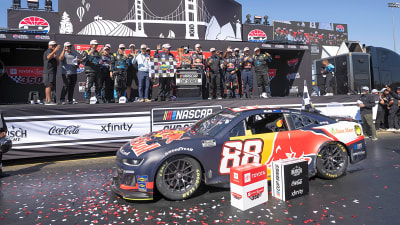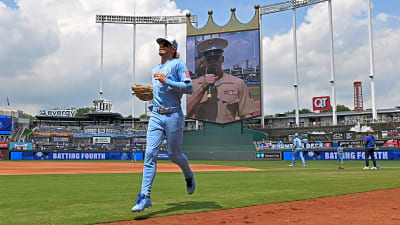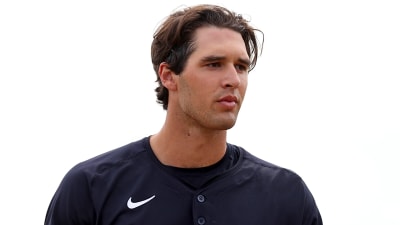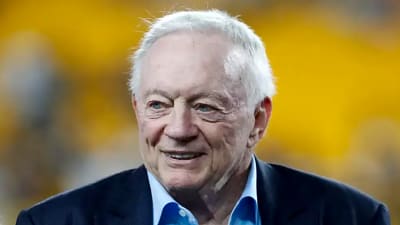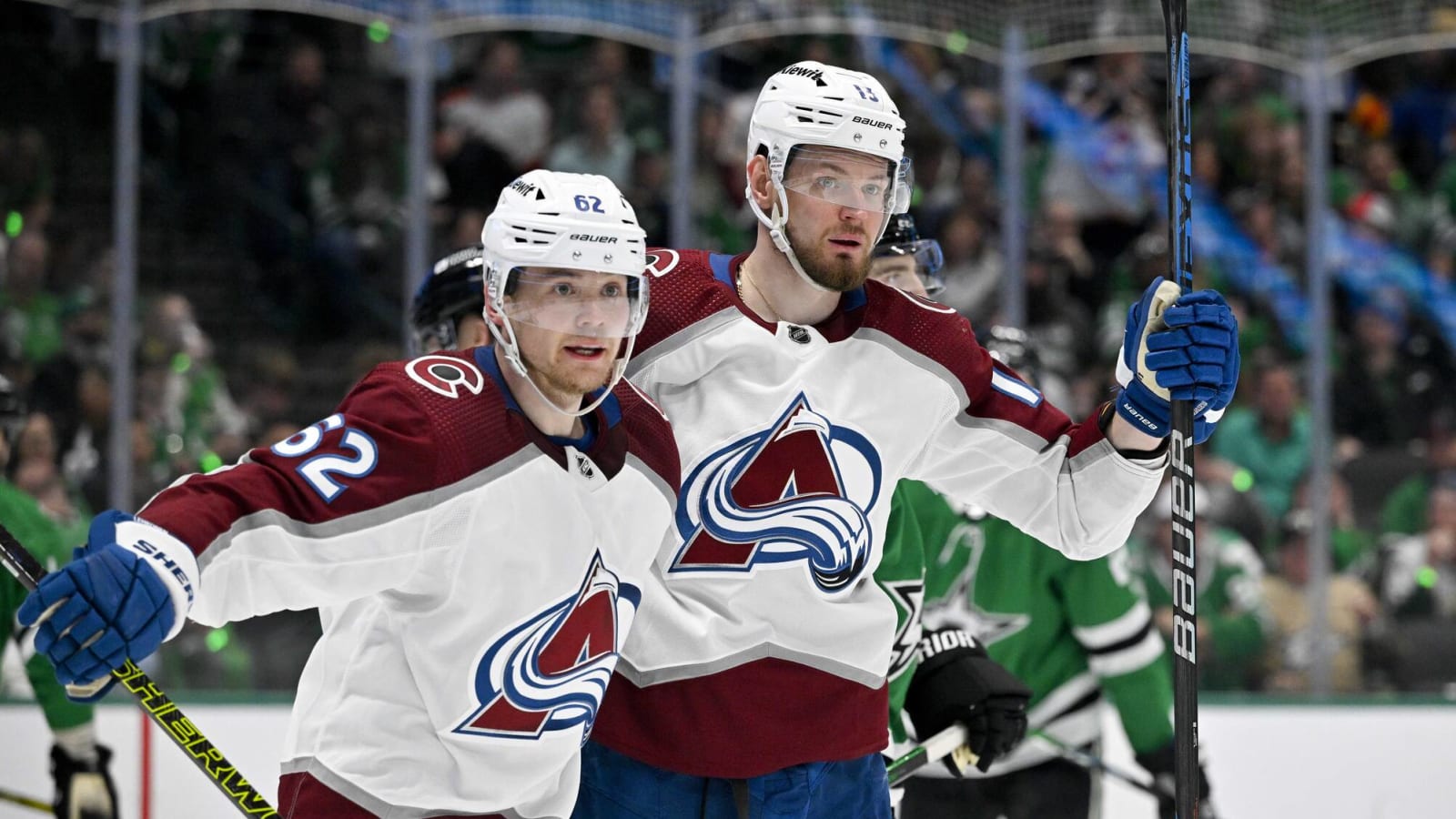
As the Colorado Avalanche lost 2-1 in overtime to the Dallas Stars to abruptly end their second-round series in defeat, it began the countdown to the start of the 2024-25 season.
Though the Stars were considered one of the favorites for the 2024 Stanley Cup due to the depth of their roster, the Avalanche have to be frustrated that another opportunity to win a championship with this core slipped away, the 2022 title notwithstanding. The series loss marks the fourth second-round exit of head coach Jared Bednar’s tenure (eight seasons) and will sting after management submitted a vote of confidence in the group at the trade deadline.
The front office made several significant trades in an attempt to bolster and re-arrange their lineup, highlighted by swapping defenseman Bowen Byram for center Casey Mittelstadt in a deal with the Buffalo Sabres. Additional moves saw Sean Walker, Yakov Trenin, and Brandon Duhaime (among others) join the fray, and all three featured regularly in the postseason.
An unexpected personnel development derailed their comeback attempt against the Stars (more on that in a bit), and now the franchise faces a great deal of uncertainty heading into the summer in terms of absent players and pending free agents. At this point, the Avalanche’s roster promises to look very different come the start of training camp.
With that, let’s dive into what should be the organization’s five biggest priorities this offseason if the goal for 2024-25 is to maintain their status as a Stanley Cup contender.
Priority No. 1: Decide on Nichushkin’s Future With the Team
There’s no sense in ignoring the elephant in the room. Winger Valeri Nichushkin – one of the NHL’s most ferocious forecheckers and dominant net-front presences – has once again run afoul of the NHL/NHLPA Player Assistance Program. The forward’s latest transgression means that he has been placed in Stage 3 of the program and will be suspended for at least six months without pay. A player is placed in Stage 4 following three violations and is hit with a one-year suspension without pay and no guarantee of reinstatement.
Nichushkin’s $6.125 million cap hit will not count against the Avalanche as long as he remains away from the team, but his eventual return ahead of next season would require the team to make room for his contract.
While being in Stage 3 is not grounds for contract termination, the Avalanche could pursue an unlikely conclusion to this story: a buyout. According to CapFriendly’s buyout calculator, such a move would save the team around $10 million over the life of the contract but would incur a cap hit between $3 and 5 million from 2026-27 through 2029-30.
A team built around expensive superstars like the Avalanche can’t afford to commit to that amount of dead cap for an extended period of time. Proceeding with Nichushkin’s return in mind may have to be the prerogative this offseason, especially since it’s unclear if the Avalanche can actually complete a buyout under the terms of the collective bargaining agreement or if they are even interested in doing so.
It’s both frustrating and concerning on a human level that Nichushkin’s situation has gotten to this point, and the Avalanche have to hope he has the external support and internal motivation to overcome his personal issues. After two consecutive playoff absences, patience (and empathy) is unfortunately running out.
Priority No. 2: Get Clarity on Landeskog’s Recovery Timeline
In a similar vein, the long-term playing future of captain Gabriel Landeskog remains in doubt. The 31-year-old winger last played in Game 6 of the 2022 Stanley Cup Final due to a lingering knee injury and underwent a surgical procedure last May – his third in two years – with his timeline for recovery set for anywhere from 12-16 months. He was not close to a return in these playoffs but did engage in light skating and drill work during the postseason.
In a season-ending press conference alongside general manager Chris MacFarland, Landeskog confirmed he won’t be retiring and reiterated his intentions of returning to NHL play at some point in the future, though the pair could not commit to a concrete timeline.
Landeskog’s timeline for a return has been adjusted multiple times over the past two seasons, which isn’t surprising given the nature of his injury and treatment plan, but the uncertainty does complicate the Avalanche’s roster-building plans for 2024-25.
As is the case with Nichushkin, the Avalanche must account for their captain’s $7 million cap hit and the possibility that he is cleared to return at some point during the 2024-25 regular season, however unlikely that is. The NHL’s salary cap limit is projected to rise to $87.7 million next season and potentially $92 million for the 2025-26 campaign.
Assuming both Landeskog and Nichushkin are unavailable, the Avalanche are projected to have $22.9 million in cap space with 13 players under contract (seven forwards, four defensemen, and two goalies).
:
If Landeskog’s recovery puts him on track to return in 2024-25, the usable space dwindles to $15.9 million. A Nichushkin return would give them around $9.8 million to utilize for at least three more forwards and two defenders. It’s evident that those two players hold the keys to the Avalanche’s offseason, and the team should prepare for at least one of them to return during the upcoming season.
Another factor is how Landeskog will perform after a lengthy absence. The uncomfortable truth is that he may never reach the heights of his peak again, and the Avalanche may have to reconcile with the fact that they may have his contract on the books for another half-decade. Outside of the personal angle, his future could have significant ramifications on the team’s competitive timeline. Do we see him in an NHL game next season?
Priority No. 3: Sign Mittelstadt to a Long-Term Extension
The deadline acquisition of Mittelstadt marked the end of a long pursuit for a legitimate top-six center, a need that was borne out of Nazem Kadri’s departure as a free agent during the 2022 offseason. While losing Byram represents a significant cost, Mittelstadt fit seamlessly within the Avalanche’s free-flowing system and could put an end to the revolving door of candidates trying their hand at being the second-line pivot.
Mittelstadt tallied 10 points in 18 regular-season games with the Avalanche while playing under 16 minutes per night as he got acclimatized to his new destination. He looked much more comfortable in the postseason, compiling nine points in 11 games while tying for the team lead in even-strength scoring (nine points). His playmaking and vision were on full display despite the club’s second-round exit, and he should be a fixture in the lineup going forward.
In order to retain Mittelstadt’s rights as a restricted free agent (RFA), the Avalanche must extend him a qualifying offer worth $2.6 million. He is coming off a three-year bridge deal worth $2.5 million annually and is eligible for salary arbitration this offseason but is set to become an unrestricted free agent (UFA) next summer should he not agree to an extension.
According to Evolving Hockey’s free agent contract projections, which are based on historical comparisons, Mittelstadt is most likely to sign a contract with an average annual value (AAV) of just under $6 million with term most likely ranging from three to five years.
| Years | AAV | Probability |
|---|---|---|
| 3 | $5.78 million | 28% |
| 4 | $5.81 million | 16% |
| 5 | $5.99 million | 26% |
The projection model estimates that the center would have to sign a one-year deal to see his AAV drop below $5 million (seven percent) and that it would take a pact of six or more years to eclipse $6 million in AAV (16%).
Though Mittelstadt is sure to look for a sizable raise and the Avalanche will need cap room to maneuver the obstacles presented by the Landeskog and Nichushkin situations, there is ample runway for an amicable compromise.
Priority No. 4: Make Decisions on Pending Unrestricted Free Agents
Outside of Mittelstadt, the Avalanche must make decisions on a handful of pending UFAs headlined by winger Jonathan Drouin, who set new career-highs in assists (37) and points (56) after signing a one-year deal with the hopes of reigniting his flagging career. His history and chemistry with junior teammate Nathan MacKinnon could sway him into taking a discount to stay in a positive situation, but he may have priced himself out of Colorado.
Evolving Hockey’s projections suggest that there is a 73% chance that Drouin will sign a deal spanning three to five years with an AAV hovering between $4.32 and $5.27 million. That would represent a considerable payday for a player whose NHL career was arguably on its last legs, but he’ll have to decide whether comfort and fit are more important than salary in any contract talks.
The Avalanche have four other notable UFA forwards and three UFA defensemen needing new contracts for next season, but a cap crunch will ensure that the vast majority will not return to Denver. Forward Zach Parise already announced his retirement prior to the start of the 2024 Playoffs.
| Player | Years | AAV | Probability |
|---|---|---|---|
| Sean Walker | 5 | $5.04 million | 40% |
| Yakov Trenin | 4 | $3.5 million | 29% |
| Brandon Duhaime | 4 | $1.92 million | 30% |
| Jack Johnson | 1 | $1.31 million | 43% |
| Andrew Cogliano | 1 | $1.13 million | 52% |
| Caleb Jones | 1 | $0.892 million | 48% |
| Joel Kiviranta | 1 | $0.835 million | 54% |
Andrew Cogliano turns 37 next month and a number of serious injuries and declining play may make retirement an appealing proposition. Utility forward Yakov Trenin and right-handed defender Sean Walker may have earned hefty free-agent deals due to their versatility and positional scarcity, but they’re likely to be too rich for the Avalanche’s blood. Brandon Duhaime, Joel Kiviranta, Jack Johnson, and Caleb Jones could all be re-signed for $2 million or less and are the likeliest to return as a result.
Regardless of which UFAs are back in the fold for the 2024-25 season, the makeup of the roster is sure to look different after the start of the free-agent period.
Priority No. 5: Graduate Prospects Into Full-Time NHL Roles
The Avalanche have several intriguing prospects in the American Hockey League (AHL) waiting for their chance at a full-time opportunity in the NHL, which could finally arrive as the roster is in flux.
Goaltender Justus Annunen finally grabbed hold of the team’s backup job in the wake of Pavel Francouz’s retirement, beating out Ivan Prosvetov. Annunen posted a .928 save percentage (SV%) in 14 games this season and will continue to battle Alexandar Georgiev for starts in 2024-25.
Jean-Luc Foudy, Oskar Olausson, and Sam Malinski could all see extended time in the NHL next season after solid showings in the AHL with the Colorado Eagles.
Foudy is speedy and versatile positionally, but a lower-body injury limited his 2023-24 campaign to 26 games, though he scored 14 points across his limited outings. Olausson is more unlikely to make the jump despite showing some offensive promise (11 goals and 20 points in 39 games) given that he has to round out the defensive side of his game before he is handed a bottom-six role in the NHL.
Malinski in particular has a clear path to a bottom-pair role, with only four NHL blueliners under contract for 2024-25. He scored 10 points in 23 games for the Avalanche this season and tallied 27 points in 46 AHL games. He is now familiar with what the team expects out of its defensemen, and his tiny cap hit ($850,000) is just the kind of value the organization is looking for in the midst of a cap crunch.
The Avalanche have struggled to develop and promote their top prospects in recent seasons, a trend that must end if the club hopes to build out an inexpensive supporting cast around its superstars.
Uncertainty Defines the Avalanche’s 2024 Offseason
The only thing that I can proclaim with any certainty is that the makeup of the Avalanche roster after this summer will look vastly different from the team that lined up against the Stars in the Western Conference Semifinal.
Landeskog’s ever-shifting timeline for recovery already promised potential cap casualties and machinations well before the Nichushkin suspension, and now the front office must fight a battle on two fronts.
With MacKinnon and Makar in the fold, the Avalanche have the difficult part of roster-building figured out. Now, the task is to surround its superstars with cost-effective support pieces while juggling the probability of one (or both) of their star wingers returning to the fold at some point next season.
The Avalanche should challenge for the Stanley Cup again in 2024-25; Can they complete a turnaround after two consecutive disappointing seasons?
Data courtesy of CapFriendly and the NHL.
More must-reads:
- NHL's 2025-26 opening night slate is a showcase opportunity for the league
- Sabres, Bowen Byram avoid arbitration with new two-year deal
- The 'No. 1 overall MLB Draft picks' quiz
Breaking News
Trending News
Customize Your Newsletter
 +
+
Get the latest news and rumors, customized to your favorite sports and teams. Emailed daily. Always free!
